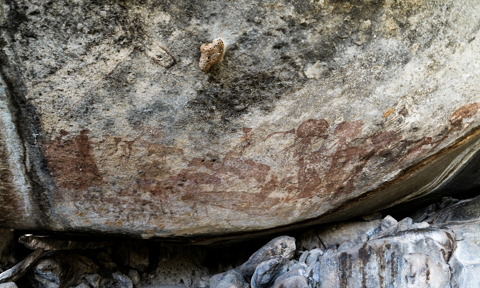
There’s a lot going on in the world that remains a mystery to most. When it’s not mysteries of outer space, it’s surprising discoveries of artifacts left behind by the humans that inhabited the planet hundreds and thousands of years ago.
Case in point is a set of rock paintings discovered in Tanzania, Africa, that have left historians and archaeologists confused.
A few years ago, archaeologists discovered 52 previously undocumented rock shelters in the Swaga Swaga Game Reserve in central Tanzania. What was notable about this discovery were the walls of the shelters which were deliberately painted with rock art.
According to archaeologist Maciej Grzelczyk of the Jagiellonian University in Poland, these paintings date back hundreds of years ago, back to the time of hunter-gatherer societies.
Most of the art had been destroyed because of weathering but a handful was preserved. This preserved art presented an enigma to archaeologists.
The site, named Amak’hee 4 was painted with a collection of figurative art, including three mysterious anthropomorphic figures with extremely oversized heads.
Over the years, many theories have been put forward, including one which claims these mysterious paintings depict buffalo heads, based on their shapes.
“In this trio, the figures seem to feature stylized buffalo heads. These shapes recall the central dip in the profile of the buffalo head from where the two horns rise and then curve outward away from the head, as well as the downturned ears,” wrote Grzelczyk in a paper published on the subject.
But the culture of the Sandawe people, those who have descended from the people who inhabited the region during the time these paintings were made, does not include any significant reference to buffaloes or buffalo-headed people. But buffalo-horns do play a role in Sandawe rituals.
More recently, another site close to Amak’hee 4 was discovered with similar paintings, including the ones with the trio of giant-headed figures. The Kolo site in the Kondoa region of central Tanzania has two rock shelters with paintings that bear a strong resemblance to the ones found at Amak’hee 4, with some differences.
“The figures from Amak’hee 4 are noticeably bigger than those at Kolo, and make this main motif a central focal point around which the rest of the narrative seems to take place. In contrast, the images at Kolo are isolated depictions, with no clear connection to the rest of the paintings,” wrote Grzelczyk.
In two of these paintings, the three figures are depicted standing together while in the third, they are lying down on the ground. However, in all three sites, the figures are connected by a line across their midsection and all three have similar arrangements and directions of their arms. Some of the rock shelters discovered at the Kondoa region are still used as ritual sites by the Sandawe people, which has led to the archaeologists working with them to understand what this art could possibly depict.
For now, work is still going on to figure out what these three giant-headed figures could mean.
- Quick links
- history
- Art
- Archaeologists






